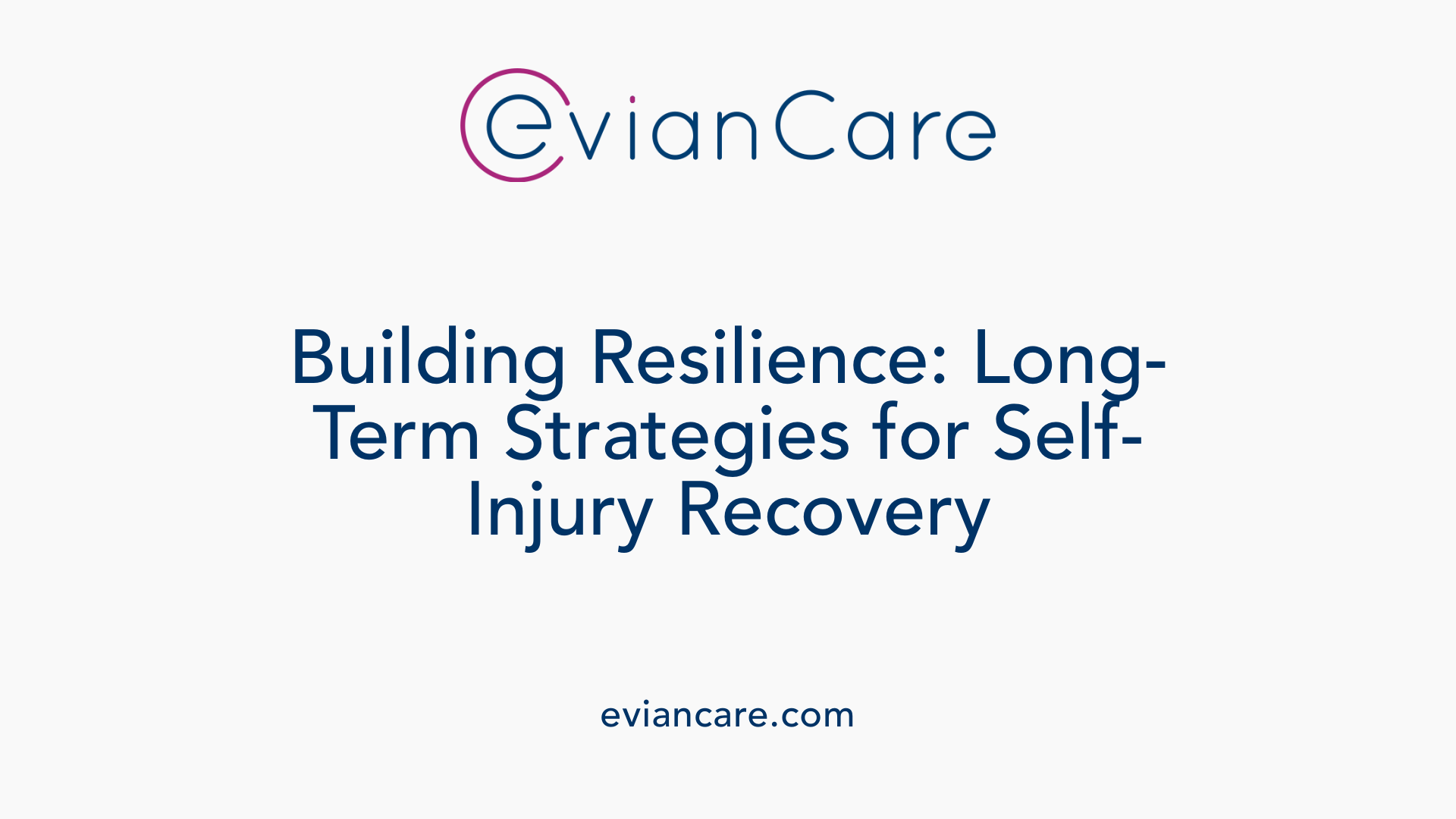
Understanding Self-Injurious Behaviors and The Role of Behavioral Interventions
Self-injurious behaviors (SIBs) are deliberate actions causing physical harm to oneself, often linked to mental health conditions such as anxiety, depression, bipolar disorder, and neurodevelopmental disorders like autism spectrum disorder (ASD). Recognizing the underlying causes—ranging from emotional distress and communication difficulties to sensory needs—is crucial for effective intervention. Behavioral therapy serves as a primary modality for managing SIBs, offering evidence-based techniques to reduce harm while addressing core emotional and cognitive factors.
Overview of Self-Injurious Behaviors and Their Causes

What are self-injurious behaviors (SIBs)?
Self-injurious behaviors (SIBs) involve deliberate actions that cause harm or potential harm to oneself. These actions include a range of physical harms such as cutting, burning, hitting, scratching, head-banging, biting, and pinching. SIBs can occur across various populations, including individuals with mental health conditions like anxiety, depression, borderline personality disorder, post-traumatic stress disorder (PTSD), and neurodevelopmental disorders such as autism spectrum disorder (ASD).
Often, these behaviors serve multiple functions for the individual. While they are not usually suicidal attempts, SIBs can lead to serious injuries, infections, nerve damage, and scars if not properly managed. Diagnosis is primarily clinical, based on physical inspection and behavioral history, since no specific laboratory tests exist for detecting SIBs.
How can self-injurious behavior be redirected or managed?
Managing self-injury involves a comprehensive approach driven by understanding its underlying function. Immediate safety is paramount, so early intervention aims to prevent harm through response blocking and substitution.
One effective strategy includes quickly intervening when SIB occurs and redirecting the individual toward safer, alternative activities. Visual cues, picture symbols, or communication devices such as picture exchange communication systems (PECS) help facilitate expression and reduce frustration.
Understanding the purpose behind the behavior—whether sensory stimulation, communication, emotional regulation, or escape—is crucial for effective intervention. Addressing these underlying needs can involve teaching alternative skills like deep breathing, art, or sensory activities.
Behavioral techniques such as differential reinforcement are used to encourage acceptable behaviors by providing positive reinforcement when alternative, non-harmful behaviors are exhibited. Response prevention strategies, like response blocking, prevent the behavior from completing.
Creating a supportive, predictable environment helps reduce anxiety and frustration, which are common triggers. Validating feelings and ensuring the individual feels heard can decrease the likelihood of self-injury.
Therapeutic approaches such as cognitive-behavioral therapy (CBT) and dialectical behavior therapy (DBT) are effective in modifying the thoughts and emotions that drive SIBs over the long term.
In the case of neurodevelopmental disorders, behavioral assessments like functional behavioral assessment (FBA) can identify the specific triggers and functions of SIBs, guiding targeted intervention plans.
Furthermore, incorporating communication support, sensory tools, and consistent routines helps address core causes. Close monitoring and collaboration with multidisciplinary teams—including speech therapists, occupational therapists, and psychologists—are vital.
This holistic management approach aims not only to prevent injury but also to understand and treat the underlying issues that contribute to self-injurious behaviors, supporting healthier ways for individuals to communicate and regulate their emotions.
Evidence-Based Behavioral Therapy Approaches for Self-Injury

How effective are Dialectical Behavior Therapy (DBT) and its adolescent adaptation (DBT-A)?
DBT, particularly adapted for teenagers (DBT-A), has demonstrated significant success in reducing self-injury and suicidal behaviors among youth. Studies show that approximately 93.5% of patients cease deliberate self-harm behavior within the first year of treatment, with an average cessation time of around 15.5 weeks. Early responders—those who stop behaviors within the first 8 weeks—comprise about a quarter of patients, and no notable differences in outcomes have been observed between early and late responders. DBT emphasizes skills such as emotion regulation, mindfulness, distress tolerance, and interpersonal effectiveness.
The therapy involves a structured approach to identify triggers and behavioral patterns through techniques like behavior chain analysis, allowing individuals to recognize antecedents to self-injury. Skills like the TIPP method—using temperature, intense exercise, paced breathing, and muscle relaxation—are taught to handle high emotional distress. These methods help clients develop healthier coping strategies that reduce reliance on self-harm.
What role does cognitive behavioral therapy (CBT) play in reducing self-harm?
CBT is one of the most extensively studied psychotherapeutic approaches for self-injury. It focuses on identifying and challenging maladaptive thoughts that lead to harmful behaviors. Through CBT, individuals learn to recognize the thoughts, feelings, and situations that precipitate self-harm and acquire healthier coping mechanisms.
This therapy promotes skills such as distress tolerance, emotional regulation, and self-awareness. Over time, CBT helps build resilience, decrease impulsivity, and challenge negative thought patterns. Research indicates that people tend to experience long-term reductions in self-injury incidents, often noticing improvements after a few sessions.
How do psychodynamic and mentalization-based therapies contribute?
Psychodynamic therapy explores unconscious emotional conflicts and past experiences influencing self-injury. It aims to increase self-understanding and awareness of underlying issues such as trauma or attachment problems.
Mentalization-Based Treatment for Adolescents (MBT-A), rooted in psychodynamic principles, encourages adolescents to understand their thoughts, feelings, and intentions, as well as those of others. An initial randomized controlled trial showed MBT-A's efficacy in reducing self-harm by strengthening emotional regulation and social cognition.
Why is family involvement and skills training important?
Across evidence-based treatments, family involvement and skills development play vital roles. Teaching emotion regulation and interpersonal effectiveness skills to both the individual and their family creates a supportive environment conducive to recovery. Family therapy, parent training, and skills workshops help improve communication, reduce conflict, and foster healthier relationships. This collaborative approach enhances treatment adherence and generalization of skills into daily life.
Techniques Used Within Behavioral Therapy to Reduce Self-Injury
Within behavioral therapy, several techniques are employed to help reduce self-injury:
- Developing alternative behaviors that serve the same function as self-harm, such as sensory activities (e.g., handling textured objects) or communication strategies.
- Building emotional regulation skills to manage feelings like frustration, anxiety, or sadness.
- Creating safety plans that outline steps to take during urges, including distraction, calling support persons, or practicing mindfulness.
- Responding calmly and consistently to self-injury episodes, using strategies like physical guidance or visual cues.
- Reinforcing positive behaviors by rewarding healthy coping efforts, increasing routine predictability to minimize triggers.
Understanding the specific function of self-injurious behavior—whether for sensory needs, escape, or communication—is crucial to tailoring interventions. Therapists often perform functional analyses to determine these triggers, enabling more effective, individualized treatment plans.
| Therapy Type | Core Focus | Techniques Employed | Evidence of Success |
|---|---|---|---|
| DBT and DBT-A | Emotional regulation, distress tolerance | Behavior chain analysis, skill training, contingency management | Over 93% cease self-harm within a year, with significant reductions in severity |
| CBT | Thought and behavior change | Cognitive restructuring, skill-building, coping strategies | Reduces self-injury long-term, effective for adolescents |
| Psychodynamic & MBT | Unconscious conflicts, emotional awareness | Exploration of past experiences, mentalization exercises | Proven efficacy in initial trials for reducing self-harm |
| Family Involvement | Support system strengthening | Skills training, communication enhancement | Improves adherence, reduces relapse |
Utilizing a combination of these therapies, tailored to individual needs, offers the best chance for reducing self-injurious behaviors and improving overall mental health.
The Efficacy of Dialectical Behavior Therapy (DBT) and Adaptations for Youth
How does cognitive-behavioral therapy (CBT) help treat self-harm?
Cognitive-behavioral therapy (CBT) plays a significant role in treating self-harm by helping individuals understand and identify the thoughts, feelings, and behaviors that contribute to their harmful actions. Through CBT, clients learn to recognize the negative thought patterns and emotional triggers that lead to self-injury.
This therapy encourages replacing unhealthy thoughts with healthier, more balanced ones. As a result, individuals develop coping strategies to manage distress and emotional discomfort more effectively. CBT also focuses on building skills such as stress management, emotion regulation, and interpersonal effectiveness, which are crucial in reducing the frequency of self-injurious behaviors.
In addition to addressing negative thought cycles, CBT often involves exploring underlying issues like trauma, depression, or anxiety, using trauma-informed techniques when necessary. By fostering healthier patterns of thinking and behavior, CBT helps individuals reduce their urge to self-harm and promotes long-term emotional stability.
This evidence-based approach has demonstrated success in decreasing self-injury, especially when combined with other therapies. Its emphasis on skill development and cognitive restructuring makes it a valuable component of comprehensive treatment plans for those engaging in self-harm behaviors.
Results from randomized controlled trials of DBT/DBT-A
Research supports the effectiveness of Dialectical Behavior Therapy (DBT), especially in adolescents and young adults. Several randomized controlled trials (RCTs) have shown promising results.
In particular, DBT adapted for adolescents (DBT-A) has been proven to significantly reduce suicidal attempts, non-suicidal self-injury (NSSI), and overall self-harm activities among youth. One notable study found that over 93.5% of participants ceased their deliberate self-harm behaviors within the first year of treatment.
The average time for cessation was roughly 15.5 weeks, with many individuals showing early improvements within the first week. These findings highlight DBT-A’s capacity to provide rapid and sustained relief from harmful behaviors.
Furthermore, no significant differences were observed between early and late responders across demographic and clinical variables, suggesting that the treatment’s effectiveness applies broadly.
Impact on suicidal attempts and NSSI
DBT, especially its adolescent adaptation, is particularly effective in reducing suicidal thoughts, attempts, and self-injury behaviors. Its success is attributed to its structured approach that combines individual therapy, skills training groups, and coaching to help youths understand and manage their affective responses.
Research indicates that DBT not only decreases self-injury incidents but also improves related symptoms such as hopelessness, depression, and emotional dysregulation, which are often underlying factors.
Key skills taught in DBT (emotion regulation, mindfulness, interpersonal effectiveness, distress tolerance)
DBT emphasizes teaching four core skill sets:
| Skill Set | Description | Examples of Techniques |
|---|---|---|
| Emotion Regulation | Managing intense and fluctuating emotions effectively | Recognizing emotions, reducing vulnerability to emotion ups and downs |
| Mindfulness | Maintaining present-moment awareness and acceptance | Meditation, observing thoughts without judgment |
| Interpersonal Effectiveness | Improving relationship skills and asserting needs | Asking for what you need, saying no, maintaining self-respect |
| Distress Tolerance | Handling crisis situations without worsening the problem | TIPP (Temperature, Intense exercise, Paced breathing, Paired relaxation), distraction techniques |
These skills enable individuals to better handle emotional stress and reduce impulsive behaviors like self-injury.
Behavior chain analysis and contingency management
A core component of DBT is Behavior Chain Analysis (BCA), a detailed process used to understand the sequence of events leading to self-harm.
BCA involves describing the behavior—such as self-injury—and identifying the links in the chain, including thoughts, feelings, and environmental cues that precede and follow the behavior. This process helps clients and therapists pinpoint specific triggers and vulnerabilities.
Contingency management, on the other hand, involves reinforcing desirable behaviors and applying consequences to reduce undesirable ones. For example, clients may learn to reinforce alternative, healthy behaviors by rewarding themselves or receiving external praise.
These approaches provide a framework for identifying patterns and implementing targeted interventions, ultimately helping individuals develop skills to prevent self-harm episodes.
| Technique | Purpose | Application Example |
|---|---|---|
| Behavior Chain Analysis (BCA) | Understanding triggers and contextual factors of self-injury | Breaking down incidents to avoid future triggers |
| Contingency Management | Reinforcing positive behaviors to replace harmful actions | Reward system for abstaining from self-harm |
Together, these tools help clients gain insight into their behaviors and build healthier routines, supporting recovery and long-term emotional health.
Behavioral Strategies in the Treatment of Self-Injury in Autism Spectrum Disorder (ASD)

What are common psychosocial interventions for self-injurious behaviors in adolescents?
Several psychosocial interventions have demonstrated effectiveness in reducing self-injurious behaviors (SIB) among adolescents, especially those with autism spectrum disorder (ASD). Among these, Dialectical Behavior Therapy (DBT) stands out as particularly effective. DBT teaches skills such as emotional regulation, distress tolerance, and mindfulness, facilitating adolescents' ability to manage intense emotions without resorting to self-injury.
Cognitive-Behavioral Therapy (CBT) is another widely used approach. It helps adolescents identify and challenge negative thoughts and feelings that may trigger self-harm. Additionally, mentalization-based therapy (MBT) enhances understanding of their own and others’ mental states, which can help in reducing impulsiveness and improving emotional control.
Family therapy and parent training are integral parts of treatment, aiming to improve communication within the family and establish a supportive environment. Group therapies, such as peer support or skills training groups, offer adolescents social connection and shared learning experiences, reducing feelings of isolation that often accompany self-injurious behaviors.
Use of functional behavioral assessment (FBA)
Functional Behavioral Assessment (FBA) is a systematic way to identify the underlying functions or purposes of self-injurious behaviors. By observing the context, antecedents, and consequences, clinicians can determine if behaviors serve functions such as communication, sensory stimulation, escape, or avoidance.
Once the function is identified through FBA, targeted interventions can be devised. For example, if self-injury functions as a form of communication, teaching alternative communication methods can reduce the behavior. If sensory stimulation is the function, providing appropriate sensory tools can help meet those needs.
Reinforcement of alternative behaviors
Reinforcing alternative behaviors is a crucial component of treatment. This involves teaching and encouraging behaviors that serve the same function as self-injury but are adaptive and socially acceptable. For instance, if a child self-injures to escape a task, teaching them relaxation techniques or requesting help can be reinforced.
Positive reinforcement of these appropriate behaviors helps increase their occurrence, reducing dependence on self-injury. For example, using preferred items or activities as rewards when the child uses an alternative behavior promotes lasting change.
Environmental modifications
Adjusting the environment can significantly decrease opportunities and triggers for self-injury. This includes modifying physical settings to reduce sensory overload, introducing calming sensory tools, and establishing predictable routines with visual supports.
Environmental modifications also encompass removing or safeguarding objects that could be used for self-harm, and structuring activities to minimize frustration and overwhelm. These changes create a safer and more supportive space that diminishes the likelihood of SIB.
Communication training, including speech therapy and visual supports
Communication deficits often underlie self-injurious behaviors in children with ASD. Providing communication training via speech therapy or alternative augmentative communication (AAC) methods helps improve their ability to express needs and frustrations.
Visual supports such as picture exchange communication systems (PECS), social stories, and schedules can facilitate understanding, predictability, and reduce anxiety, all of which decrease the likelihood of self-injury. Enhancing communication skills offers a pathway for children to advocate for themselves non-destructively.
| Intervention Type | Main Focus | Example Methods | Effectiveness in Autism Spectrum Disorder |
|---|---|---|---|
| Functional Behavioral Assessment (FBA) | Identifies triggers and functions of self-injury | ABC charts, observations | Essential for individualized treatment planning |
| Reinforcement of Alternative Behaviors | Builds adaptive skills similar to self-injury | Teaching communication/relaxation | Highly effective when consistently applied |
| Environmental Modifications | Reduces triggers and stressors | Visual supports, sensory tools | Significant reduction in SIB incidents |
| Communication Training | Empowers expression of needs | Speech therapy, AAC devices | Critical for reducing frustration-driven behaviors |
Understanding and implementing these interventions require coordinated effort among behavioral therapists, speech-language pathologists, families, and educators. Personalized strategies, based on comprehensive assessments, often yield the best results in managing self-injurious behaviors in children with ASD.
Preventing and Reducing Self-Injury through Behavioral Techniques
What are response blocking and response prevention?
Response blocking and response prevention are behavioral strategies used to directly interrupt self-injurious actions. Response blocking involves physically preventing the individual from engaging in self-injury whenever the behavior occurs, thereby creating a pause that allows for alternative behaviors to be introduced. Response prevention focuses on inhibiting the response pattern that leads to self-harm, often by withholding reinforcement that might otherwise maintain the behavior.
In practice, these techniques require careful planning and often involve caregivers or therapists who are trained to implement the interventions safely. Consistent application helps individuals learn that self-injury will not produce the expected relief or sensory input, encouraging the development of healthier coping behaviors.
Reinforcement of positive and alternative behaviors
A core element in behavioral intervention is reinforcing behaviors that are incompatible with self-injury or serve as healthier alternatives. For example, when a child or adolescent begins to use a communication device instead of biting or head-banging, this behavior is reinforced through praise or tangible rewards.
Similarly, engaging in sensory activities like squeezing a stress ball or using tactile toys can serve as effective alternatives to self-harm for sensory stimulation. Reinforcement techniques are designed to strengthen these adaptive behaviors, gradually reducing reliance on self-injury.
Growing evidence supports that combining differential reinforcement—rewarding appropriate responses while withholding reinforcement for self-harm—can significantly decrease harmful behaviors over time.
The importance of routine and predictability
Creating a predictable environment helps reduce anxiety and prevent triggers that may lead to self-injury. Establishing structured daily routines, consistent schedules, and clear expectations provide a sense of stability for individuals with neurodevelopmental disorders or emotional dysregulation.
Preparation through social stories, visual schedules, and routine priming reduces uncertainty, which in turn decreases distress and impulsivity. When individuals know what to expect, they are more likely to feel secure and less prone to engaging in self-injurious behaviors as a form of escape or expression.
Skills development in emotional regulation and distress tolerance
Teaching adolescents skills to regulate their emotions and tolerate distress is fundamental to reducing self-injury. Programs like Dialectical Behavior Therapy (DBT) aim to equip individuals with tools such as mindfulness, emotion regulation, and distress tolerance.
Distress tolerance skills — including techniques like TIPP (Temperature, Intense exercise, Paced breathing, and Paired muscle relaxation) — help individuals get through moments of high emotional arousal without resorting to self-harm.
Building these skills involves practice and reinforcement, enabling individuals to identify emotional triggers and respond in healthier ways. By expanding their repertoire of coping strategies, adolescents can better manage overwhelming feelings, reducing the need for self-injury as a coping mechanism.
| Technique | Description | Benefits |
|---|---|---|
| Response Blocking | Physically preventing self-harm | Interrupts behavior, introduces opportunities for teaching alternatives |
| Response Prevention | Withholding reinforcement | Reduces reinforcing effects of self-injury |
| Positive Reinforcement | Reward for alternative behaviors | Strengthens healthy responses |
| Routine and Predictability | Structured daily patterns | Decreases anxiety and reduces triggers |
| Skills Training | Emotional regulation and distress tolerance | Improves coping, decreases impulsive acts |
Understanding and implementing these behavioral techniques can be highly effective in managing self-injurious behaviors, especially when combined with family involvement and comprehensive treatment plans. Continuous monitoring and adjustment ensure strategies meet each individual’s unique needs, fostering safer coping mechanisms and long-term improvement.
Combining Pharmacotherapy and Behavioral Therapy in Managing SIBs
What behavioral therapies are effective for self-injurious behavior?
Effective behavioral therapies for self-injurious behavior include Dialectical Behavior Therapy (DBT) and Cognitive-Behavioral Therapy (CBT), both of which have demonstrated evidence of success.
DBT is particularly designed to help individuals with emotion regulation issues. It teaches skills in distress tolerance, mindfulness, emotion regulation, and interpersonal effectiveness. These skills are crucial for managing intense emotions that often trigger self-harm episodes. DBT's structured approach involves individual therapy, group skills training, and phone coaching, creating a comprehensive support system.
CBT focuses on helping individuals recognize and challenge maladaptive thoughts that contribute to self-injury. It promotes the development of healthier coping strategies by identifying triggers and cognitive distortions related to self-harm behaviors. Through skill-building and cognitive restructuring, CBT encourages alternative responses to emotional distress.
Other approaches like Functional Analytic Psychotherapy (FAP) and Exposure and Response Prevention (ERP) are also utilized in specific contexts to modify behavior patterns. These therapies often work best when integrated into personalized treatment plans that involve family support, skills training, and continuous monitoring.
In summary, combining these therapies with tailored interventions can significantly improve outcomes for individuals engaging in self-harm, reducing both the frequency and severity of behaviors.
Use of medications such as risperidone and aripiprazole
Pharmacological options play an important role when behavioral interventions need reinforcement or when underlying psychiatric conditions contribute to self-injury. Second-generation antipsychotics such as risperidone and aripiprazole are among the most studied and widely used medications.
Risperidone has shown to significantly reduce irritability and self-injurious behaviors in children with autism spectrum disorder (ASD) over an 8-week period. Common side effects include weight gain, increased appetite, sedation, and extrapyramidal symptoms, necessitating careful monitoring.
Similarly, aripiprazole has demonstrated efficacy in decreasing irritability and SIBs in children aged 6-17 with ASD in clinical trials. Its side effect profile differs somewhat, often including fewer metabolic issues compared to risperidone.
Adjunctive pharmacotherapies like NAC, riluzole, and others
In addition to antipsychotics, other pharmacotherapies are under investigation. These include:
| Medication | Purpose | Evidence | Notes |
|---|---|---|---|
| N-acetylcysteine (NAC) | Behavior improvement, reduction in SIBs | Small trials show promise | Further research needed |
| Riluzole | Modulation of glutamate, potential in reducing impulsivity | Small case series report positive results | Limited evidence |
| Clonidine | Managing hyperarousal and sleep disturbances | Case reports support use | Not primary treatment |
| Topiramate | Mood stabilization, possible reduction in self-harm | Mixed evidence | Requires careful management |
| Naltrexone | Controlling compulsive behaviors | Some positive findings | Used off-label |
These medications are generally considered adjuncts to therapy, tailored to individual needs, and often used when behavioral treatments alone are insufficient.
When pharmacotherapy is indicated
Medication is recommended in cases where:
- There are significant underlying mental health conditions like severe depression, bipolar disorder, or anxiety that contribute to self-injury.
- Behavioral therapies have not yielded sufficient improvement.
- There is a risk of severe harm or danger that requires immediate stabilization.
- Comorbid neurodevelopmental disorders, such as ASD, where medication can target specific symptoms like irritability or hyperactivity.
Pharmacotherapy should always be part of an overall treatment plan that includes psychotherapy and supports family involvement.
Monitoring and individualized treatment plans
Effective management of self-injurious behaviors requires personalized treatment strategies. Regular monitoring of medication effects and side effects is crucial to ensure safety and efficacy.
Clinicians should tailor medication choices based on the patient's age, comorbid conditions, response to previous treatments, and potential adverse effects. Ongoing assessment helps adjust doses, switch medications if necessary, and address emerging issues.
In addition, combining pharmacotherapy with behavioral interventions tends to produce the best outcomes. Family education, regular follow-ups, and supportive therapy help sustain progress and prevent relapse.
In conclusion, integrating pharmacological options with evidence-based behavioral therapies offers a comprehensive approach to managing self-injurious behaviors. While medications like risperidone and aripiprazole are more established, ongoing research into adjunctive treatments continues to expand our options. Personalized, closely monitored plans maximize safety and therapeutic success.
Supporting Long-Term Recovery and Coping Strategies

What are common psychosocial interventions for self-injurious behaviors in adolescents?
Psychosocial interventions play a vital role in helping adolescents manage and overcome self-injurious behaviors (SIBs). Among the most well-established is Dialectical Behavior Therapy (DBT), which emphasizes teaching skills related to emotion regulation, distress tolerance, mindfulness, and interpersonal effectiveness.
DBT has been shown to significantly reduce self-harm and suicidal ideation in youth, with over 93% of patients ceasing deliberate self-harm within a year of treatment initiation. It can be provided in individual or group settings and helps adolescents understand the links between their thoughts, feelings, and behaviors.
Another widely utilized approach is Cognitive-Behavioral Therapy (CBT). CBT helps individuals identify negative thought patterns that trigger self-injury, challenge distorted beliefs, and develop healthier coping strategies. It offers practical skills like recognizing triggers, increasing distress tolerance, and reinforcing positive behaviors.
Mentalization-Based Treatment for Adolescents (MBT-A) is a psychodynamic therapy approach focusing on improving the adolescent's ability to understand their own and others' mental states. This understanding reduces impulsive and emotionally driven actions, thereby decreasing self-injurious acts.
Family therapy also plays a crucial role by improving communication, addressing familial issues, and fostering a supportive environment. When families are involved, adolescents often show better engagement with treatment and stronger social support.
In addition to individual therapies, group therapy settings—such as dialectical behavior groups or peer support groups—offer adolescents a sense of community and shared experience. These settings can diminish feelings of isolation and promote mutual encouragement.
Overall, a comprehensive, individualized approach combining these therapies with family involvement offers the best chance for long-term recovery and resilience.
How can self-care activities support recovery?
Incorporating self-care routines into daily life can significantly bolster recovery efforts. Engaging in physical activities like yoga, walking, swimming, or dancing helps release stress and distracts from emotional distress.
Mindfulness practices, such as meditation or deep breathing exercises, improve emotional regulation and reduce anxiety, often preventing impulsive self-injury.
Creative outlets, including art, music, writing, or baking, provide expressive ways to process difficult feelings while fostering a sense of control and self-compassion.
Practicing relaxation techniques, like guided imagery or visualization, can calm mental noise and diminish cravings for self-harm.
Healthy routines—such as maintaining a balanced diet, ensuring restorative sleep, and staying physically active—are fundamental in stabilizing mood and increasing resilience against urges.
Building a Support Network for Sustainable Well-Being
A supportive environment is essential for ongoing recovery. Friends, family members, teachers, and mental health professionals should be educated about self-injury and means to provide non-judgmental support.
Encouraging open communication and active listening fosters trust and helps adolescents feel understood and accepted.
Connecting with peer support groups or community programs provides additional outlets for sharing experiences and gaining encouragement.
Maintaining regular contact with mental health providers ensures ongoing assessment and adjustments to treatment plans.
Relapse Prevention and Planning for Challenges
Relapse can be part of the recovery process. Developing personalized relapse prevention plans helps adolescents recognize early warning signs and triggers.
These plans should include specific coping strategies like engaging in self-care activities, reaching out for support, or using learned skills from therapy.
Keeping a journal to track emotions and behaviors can help adolescents identify patterns and intervene early.
In times of high stress, having emergency contacts or crisis resources readily available proves crucial.
Reinforcing the importance of ongoing therapy attendance and medication adherence enhances effectiveness.
Importance of Individualized Treatment Approaches
Every adolescent's experience with self-injury is unique, influenced by personal history, mental health conditions, family dynamics, and social circumstances.
Customized treatment plans that consider these factors are more likely to succeed.
Therapists and caregivers should collaborate to set realistic goals and choose interventions aligned with the individual's needs, strengths, and preferences.
Flexibility in adjusting strategies over time helps sustain engagement and long-term success.
By prioritizing personalized care, fostering support networks, encouraging self-care, and preparing for setbacks, adolescents are better equipped to build healthier coping mechanisms and achieve lasting recovery.
Conclusion: The Path to Long-Term Management of Self-Injury
Self-injurious behaviors (SIBs) are complex actions often rooted in emotional distress, communication challenges, sensory needs, or underlying mental health disorders. Addressing these behaviors requires a comprehensive, individualized approach that combines various therapeutic strategies and supportive interventions.
Effective management begins with understanding the function or reason behind the behavior, which can be identified through assessments like Functional Behavioral Analysis (FBA). This understanding guides tailored interventions, such as teaching alternative communication methods, providing sensory tools, and reinforcing positive behaviors.
Psychotherapies like Cognitive Behavioral Therapy (CBT) and Dialectical Behavior Therapy (DBT) are fundamental in reducing self-injury. CBT helps individuals recognize and challenge negative thoughts and develop healthier coping skills, while DBT emphasizes emotional regulation, mindfulness, and interpersonal effectiveness. Psychodynamic approaches explore underlying emotional conflicts to foster insight and behavioral change.
In more severe or persistent cases, pharmacotherapy, such as second-generation antipsychotics (e.g., risperidone, aripiprazole), may be used as adjuncts to therapy, especially in youths with neurodevelopmental conditions like autism spectrum disorder (ASD). These medications can help manage irritability, hyperarousal, or mood disturbances contributing to self-injury.
Behavioral modification strategies—including positive reinforcement, response blocking, extinction procedures, and environmental modifications—play a central role in reducing frequency and severity of SIBs. Teaching communication skills and providing alternative outlets for sensory or emotional needs are effective preventive measures.
Beyond professional treatments, self-care activities such as physical exercise, creative arts, mindfulness practices, and spending time in nature can serve as valuable coping tools. Encouraging individuals to engage in enjoyable activities, maintain routines, and seek social support fosters resilience.
Family and friends are crucial in the recovery process. Educating loved ones about the nature of self-injury, promoting non-judgmental support, and involving them in intervention plans enhances the effectiveness of treatment and creates a safe, nurturing environment.
Continued development of coping skills and emotional awareness is vital. Techniques like journaling, visualization, and engaging in hobbies provide ongoing outlets for expression and stress relief.
Ultimately, the path to managing self-injurious behavior is ongoing and adaptable. Combining evidence-based therapies with supportive surroundings, medication when appropriate, and active self-care lays the foundation for long-term reduction and healthier functioning.
How can self-injurious behavior be redirected or managed?
Self-injurious behavior can be managed by quickly intervening to prevent harm and then redirecting the individual to safer, alternative activities using clear communication, visual cues, or picture symbols. Understanding the function or reason behind the behavior—such as seeking sensory input, communication, or emotional regulation—is crucial. Addressing these underlying needs through reinforced coping strategies like deep breathing, engaging in creative activities, or utilizing sensory tools can diminish reliance on self-harm. Behavioral techniques such as response blocking, differential reinforcement, and providing sensory or communication supports further promote positive alternatives. Building a supportive, validating environment and collaborating with professionals through therapies like CBT or DBT are essential steps toward long-term management and reduction of self-injurious behaviors.
This comprehensive, multimodal approach emphasizes patience, consistency, and support, fostering resilience and well-being over time. Ongoing skills development, family involvement, and professional guidance are vital components in guiding individuals toward healthier, safer pathways.
Moving Forward with Effective Strategies
Managing self-injurious behaviors requires a comprehensive approach that combines evidence-based behavioral therapies, environmental modifications, and supportive interventions. Therapies like DBT and CBT have demonstrated strong efficacy, especially when tailored to the individual's needs and developmental level. Addressing underlying causes, reinforcing positive behaviors, and developing emotional regulation skills are essential components of long-term management. Collaboration among mental health professionals, families, and individuals ensures that interventions are sustained and adapted over time. With ongoing support, skill-building, and effective intervention strategies, individuals can reduce self-injury and achieve improved emotional well-being and quality of life.
References
- Treatments for Self-Injurious Thoughts and Behaviors in Youth
- Self-injury/cutting - Diagnosis and treatment - Mayo Clinic
- Causes and Interventions for Self-Injury in Autism
- Treatment For Self-Harm Behavior: Therapy, Medications, & More
- Management of Self-Injurious Behaviors in Children with ...
- Self-Injurious Thoughts & Behaviors - Effective Child Therapy
- CBT for Self-Harm | Charlie Health
- How Dialectical Behavior Therapy Treats Self Harm | Sheppard Pratt
- Treatment for Self-Harm - Discovery Mood & Anxiety Program
- Intervention Strategies for Self-Injurious Behaviors - Watson Institute












